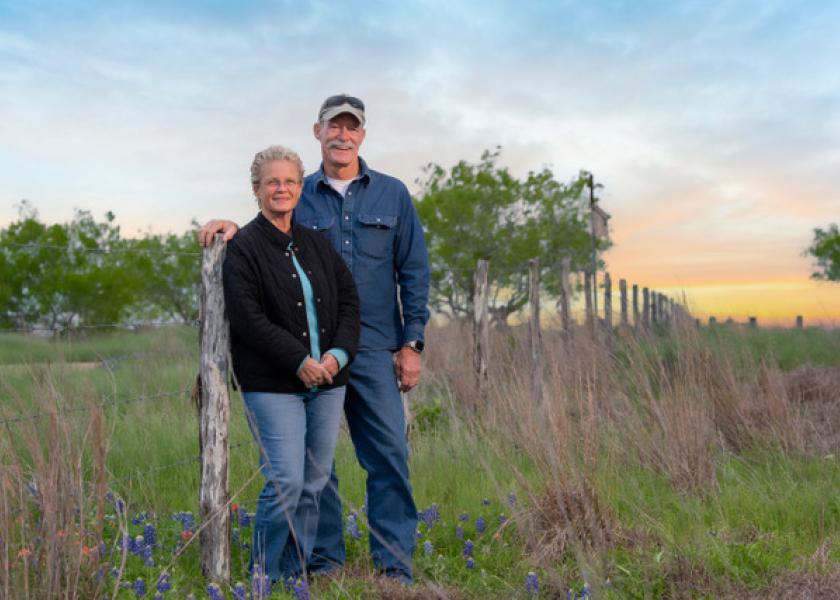Brown Ranch Receives Texas Leopold Conservation Award

Brown Ranch is the recipient of the 2023 Texas Leopold Conservation Award®.
Given in honor of renowned conservationist Aldo Leopold, the award recognizes farmers, ranchers, and forestland owners who are improving soil health, water resources, and wildlife habitat on their working land.
In Texas, the award is presented annually by Sand County Foundation and national sponsor, American Farmland Trust, in partnership with the Texas Parks and Wildlife Department’s Lone Star Land Steward Awards program.
The state’s highest honor for private land conservation and its $10,000 award will be presented to Mark and Cheryl Brown of La Grange at the Lone Star Steward Awards banquet on May 25.
“Mark and Cheryl Brown have proven that you don’t need thousands of acres to make a Texas sized impact on the landscape,” said Kevin Mote, Texas Department of Parks and Wildlife’s Private Lands and Public Hunting Program Director. “Their love for wild things and places coupled with a strong determination to first educate themselves and then pass that knowledge on to so many others truly sets them apart from the crowd.”
“The recipients of this award are examples of how Aldo Leopold’s land ethic is alive and well today. Their dedication to conservation shows how individuals can improve the health of the land while producing food and fiber,” said Kevin McAleese, Sand County Foundation President and CEO.
“As the national sponsor for Sand County Foundation’s Leopold Conservation Award, American Farmland Trust celebrates the hard work and dedication of the Texas recipient,” said John Piotti, AFT president and CEO. “At AFT we believe that conservation in agriculture requires a focus on the land, the practices and the people and this award recognizes the integral role of all three.”
The first Texas Leopold Conservation Award was presented to Richards Ranch of Jacksboro in 2005. The John Bunker Sands Wetland Center of Combine received the 2022 award.
In his influential 1949 book, A Sand County Almanac, Aldo Leopold called for an ethical relationship between people and the land they own and manage, which he called “an evolutionary possibility and an ecological necessity.”
The Leopold Conservation Award in Texas is made possible thanks to the generous contributions from American Farmland Trust, Texas Parks & Wildlife Department, Lee and Ramona Bass, Dixon Water Foundation, Sand County Foundation, and McDonald’s.
Sand County Foundation, and national sponsor American Farmland Trust, present the Leopold Conservation Award to private landowners in 25 states for extraordinary achievement in voluntary conservation. For more information on the award, visit www.leopoldconservationaward.org
Mark and Cheryl Brown looked at land as an investment before they became invested in their land. Restoring native prairie has become a labor of love for the Browns, who purchased 80 acres of worn-out hay fields and over-grazed pastures in 2000.
Located in Fayette County, the restored Blackland Prairie found on Brown Ranch has nearly disappeared in Texas. The ranch is located between Houston, San Antonio, and Austin, where a growing human population leads to shrinking parcel sizes and greater fragmentation of ecosystems.
The Browns saw the opportunity to do something special with their land. Grazing was temporarily ceased to let the pastures rest. They began the long and difficult processes of removing invasive Eastern Red Cedars and reseeding clay soils with native tallgrasses and wildflowers. Deep-rooted warm-season grasses sequester carbon in their root mass, while increasing water infiltration and reducing soil erosion. The flowering forbs provide nectar to butterflies on their annual southern migration.
The Browns periodically till areas to promote forb growth. A prescribed burning program removes undesirable grasses while stimulating growth of native milkweed critical for Monarch butterflies.
Seeing the impact of their stewardship inspired the Browns to buy another 120 acres to protect, restore and enhance the diversity and health of the native plant community. They leased nearby parcels that they were unable to purchase. Surveys conducted by Texas Parks and Wildlife Department have documented more than 250 species of native plants on parcels owned by the Browns.
Brown Ranch became an example of what’s possible in a rapidly fragmenting state when landowners utilize the local, state, and federal tools available to them. Mike and Cheryl’s conservation efforts earned them a Lone Star Land Steward Ecoregion Award (representing the Blackland Prairie ecoregion) in 2017.
Since then, their impact has only grown. They experiment with rotational and patch burn grazing strategies, provide supplemental feed to white-tailed deer, and maintain bluebird houses.
The Browns developed a management plan more than 15 years ago to attract grassland birds whose breeding populations have been declining due to habitat loss. Annual songbird surveys frequently observe birds taking cover in the tallgrass prairie.
While Brown Ranch might have started as a passion project, its owners have stretched their conservation ethic far beyond their ranch gates. The Browns are leaders in the Fayette Prairie Chapter of the Native Prairie Association of Texas and the South Central Texas Prescribed Burn Cooperative.
The diversity of Brown Ranch’s soil types and plant communities is matched by the diversity of outreach events the Browns have helped plan and host. They include webinars and field days on brush control, grazing management, pollinators, prescribed burning techniques, and cost share incentive programs. The Browns realize cooperative efforts among owners of relatively small parcels of land is the key to achieving landscape-scale conservation.
By restoring the native ecosystem on their land, providing technical guidance to their peers, and becoming regional conservation leaders, the Browns are doing their part to protect one of the most imperiled ecosystems, the grasslands of North America. They are achieving all of this with the methods that Aldo Leopold considered the basics of wildlife management: the axe, cow, plow, and fire.







